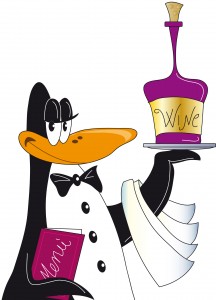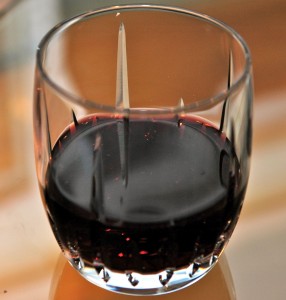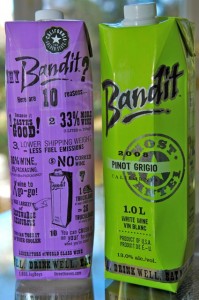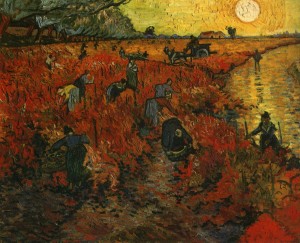by Lorri | Nov 11, 2009 | UnCorked
 From ravens and black swans to dancing bulls and leaping frogs, “critter labels” continue to catch the wine shopper’s eye. A critter label is any wine label that includes a depiction of an animal.
From ravens and black swans to dancing bulls and leaping frogs, “critter labels” continue to catch the wine shopper’s eye. A critter label is any wine label that includes a depiction of an animal.
In 2001, Australia’s Yellow Tail brand blazed the way with not only value and low cost but also a label — featuring a wallaby — that wine consumers found attractive and straightforward, setting it apart from the thousands of confusing labels.
Using critter labels to market wine isn’t new to Americans. Since the early 1980s, Frog’s Leap and Duckhorn Wine Co. have been earning respect for exceptional premium wines. As new and younger wine drinkers entered the market, companies began offering easy to understand labels with eye-catching animal images. A 2006 ACNielson report said that of the “438 new table wine brands … introduced in the past three years 77 (18 percent) featured a ‘critter’ on the label. Combined with existing critter labels … these wines have reached more than $600 million” in sales.
Today, companies are using not just animals but whimsical, fun, fuzzy and even sexy labeling. Not a bad idea considering the sometimes overwhelming feeling that buying wine can entail. If you had wonderful French Bordeaux last week for dinner, the search for it again is more difficult when it is shelved with others that look relatively the same. So remembering a bright yellow flower, penguin or bull makes sense for many wine drinkers.
THE VALUES
- 2008 Dancing Bull Zinfandel, California (about $12 retail)
- 2008 Yellow Tail Pinot Grigio, Australia (about $10 retail)
- 2008 Toad Hollow Eye of the Toad Dry Pinot Noir Rose, California (about $12 retail)
- 2007 3 Blind Moose Pinot Grigio, California (about $11 retail)
- 2007 Rex Goliath Cabernet Sauvignon , California (about $9 retail)
- 2008 The Little Penguin Merlot, Australia (about $13 retail)
THE SPLURGES
- 2006 Frog’s Leap Merlot, California (about $52 retail)
- 2008 Ravenswood Napa Valley Zinfandel, California (about $22 retail)
- 2005 Bell Big Guy Red, California (about $30 retail)
- 2006 Duckhorn Paraduxx, California (about $59 retail)
- 2007 Wild Horse Chardonnay, California (about $25 retail)
by Lorri | Nov 8, 2009 | Lorri's Wine Diary
 We had a wonderful dinner party last night. It was perfect except for one thing … I poured a wine into a glass; and it smelled like a wet dog, soggy cardboard and mildewed wool!
We had a wonderful dinner party last night. It was perfect except for one thing … I poured a wine into a glass; and it smelled like a wet dog, soggy cardboard and mildewed wool!
I tried not to panic knowing I had other red wines we could open. But I had been saving this wine and really wanted to share this bottle with friends. I smelled again … same smell. I grabbed another glass poured a small taste … no smells! Same wine … different glasses.
I learned a lesson I am always preaching … soap and detergents even in minuscule amounts on a wine glass can completely change the aromas of wine. Looks like no more cheating with the dishwasher, and I am back to hand washing all my glasses in hot water.
by Lorri | Nov 7, 2009 | Lorri's Wine Diary
 The carton wine I tasted is the 2007 Bandit Pinot Grigio and Cabernet Sauvignon. It’s not a “growth Bordeaux” but is clean and fresh and works great for anyone looking for inexpensive, simple wines.
The carton wine I tasted is the 2007 Bandit Pinot Grigio and Cabernet Sauvignon. It’s not a “growth Bordeaux” but is clean and fresh and works great for anyone looking for inexpensive, simple wines.
I like the wine but love the packaging. The back of the wine carton is smart and catchy, Why Bandit? Here are 10 reasons:
- taste good
- 33% more wine (1 liter versus 750 m.l.)
- Lower shipping weight = less fuel emissions
- 96% wine, 4% packaging.
- No corked wine.
- Wine to go-go
- 1 truckload of empty Bandit cartons = 26 truckloads of glass
- Made from renewable resources
- You can toss it in your cooler
- You can crush it on your forehead when you are finished.
by Lorri | Nov 4, 2009 | UnCorked
After many years of debate among wine writers, “terroir” continues to be one of the most discussed wine terminologies. Is it important to the consumer or simply another confusing term? I am one for the magic lure of terroir, believing grapes can be planted anywhere but grapes for great wines have a magical taste, boasting their perfect site on earth.
Terroir is the natural environment of the place a grape is grown. Another way of putting it is micro-climate, the trilogy of soil, climate and grape variety. But topography, daily temperatures, rainfall, mineral composition, plant vigor, sunlight and even whether the grapes are growing in a valley or on a hillside all contribute to the grape’s characteristics.
The climate, including temperature, influences the quality and styles of the wine. The temperature of the climate determines exactly which grapes will thrive, which won’t ripen and which will over-ripen.
Grapevines need soils that will drain excess water, store moisture and force the vines to grow deep into the ground, gaining minerals along the way. Perfect soils for winemaking are not necessarily the most fertile. Quality grapes can be found growing among weeds and olive trees in areas that would be considered inhospitable for other crops.
So a certain grape growing in the consummate soil mix with the perfect climate is the essence of terroir.
Historically, the French voiced strong opinions about terroir. This is likely because most French vineyards were small and the distinct differences in taste between two wines of the same type were easily noticed, whereas outside of Europe most vineyards were large plantings and the differences were less prominent. Today, many in the world embrace the belief in terroir, noting that a sauvignon blanc from Sancerre tastes completely different from the acidic green-apple tastes from New Zealand, and that chardonnay from Burgundy tastes much different from California’s Napa Valley expression.
Is one better than the other? Explore for yourself.
But I think discovering the terroir of wines is a magical journey in itself.
Bordeaux, France
THE VALUE
- 2007 Chateau Bonnet Sauvignon Blanc, France (about $12 retail)
THE SPLURGE
- 2006 Chateau Lascombes Margaux, France (about $150 retail)
New Zealand, South Island, Marlborough
THE VALUE
- 2008 Spy Valley Sauvignon Blanc, New Zealand (about $17 retail)
THE SPLURGE
- 2007 Cloudy Bay Sauvignon Blanc, New Zealand (about $39 retail)
Coonawarra, South Australia
THE VALUE
- 2007 Lindemans (Coonawarra) Shiraz / Cabernet Sauvignon , Australia (about $13 retail)
THE SPLURGE
- 2006 Jim Barry McRae Wood Shiraz, Australia (about $57 retail)
Napa Valley California
THE VALUE
- 2007 Martin Ray Napa Valley Cabernet Sauvignon, California (about $25 retail)
THE SPLURGE
- 2006 Bell Napa Valley Cabernet Sauvignon , California (about $86 retail)
by Lorri | Nov 1, 2009 | Lorri's Wine Diary
Last week I tried a taste test of wine in a carton. Priced at $7, I thought of course I would give it a try. Amazingly, wonderful value wine. Had the Pinot Grigio and thought it was comparable if not better than many of the $10 bottles. I’ll try a few other styles and write about it soon.
by Lorri | Nov 1, 2009 | Lorri's Wine Diary
Thank you Scott. It’s perfect!
 From ravens and black swans to dancing bulls and leaping frogs, “critter labels” continue to catch the wine shopper’s eye. A critter label is any wine label that includes a depiction of an animal.
From ravens and black swans to dancing bulls and leaping frogs, “critter labels” continue to catch the wine shopper’s eye. A critter label is any wine label that includes a depiction of an animal.

